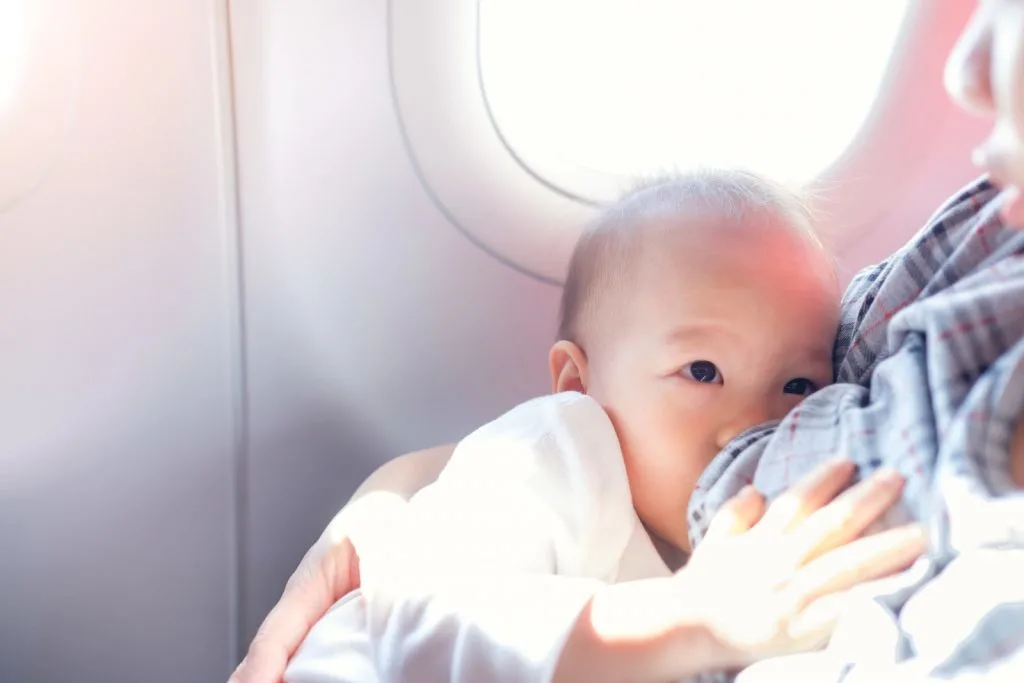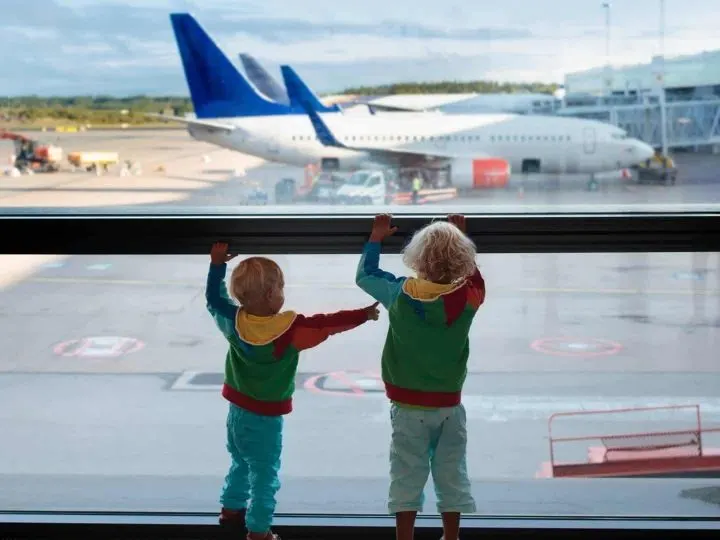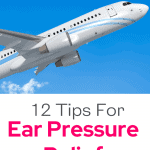My kids have been flying since they were three months old and since the beginning, they have experienced painful ear pressure while flying.
When they were babies, I could nurse them to ease the pain, but now at 9 and 6-years-old, the pain can still be unbearable. Luckily, I have found some keys to ear pressure relief.
What Causes Ear Pressure Pain When Flying?
This is how my son feels when he is experiencing painful ear pressure while flying.
The National Institute of Health describes ear pressure, also known as Ear Barotrauma, as “discomfort…in the ear due to pressure differences between the inside and outside of the eardrum.”
The NIH continues explaining that the “air pressure in the middle ear is usually the same as the air pressure outside of the body. The Eustachian tube is a connection between the middle ear and the back of the nose and upper throat.”
The Eustachian tube opens and air flows into the middle ear when we swallow or yawn and thus keeps the “air pressure on both sides of the eardrum equal.”
Barotrauma, or ear pressure pain, can occur when the Eustachian tube is blocked and the “air pressure in the middle ear is different than the pressure on the outside of the eardrum.”
If a child flies with an ear infection, the results can be awful, but even allergies, head colds, and respiratory infections can make matters worse.
What does ear pressure pain feel like? For my children it’s a lot of piercing, needle-like pain in the ear, pressure that feels like you’ve gone too far under water, and full on screaming pain until we land.
Other children may experience dizziness, slight hearing loss, or nosebleed.
Planning a getaway? Use this house checklist to prepare you home before you travel.
Ear Pressure Relief- What to do to Prevent Ear Pressure Pain

Ear Pressure Relief Advice From a Flight Attendent
Sydney Pearl, an active flight attendant and author of Diary of a Pissed-Off Flight Attendant, says
Depending on the illness, if a child starts holding their ears and screaming during landing or takeoff, their ears may be blocked. The best way to unclog blocked ears is to give them some gum or ice to chew on. Working their jaw will cause their ears to unplug. If your child has an ear infection, ask the flight attendants for a styrofoam cup with hot paper towels inside the cup. Hold the cup over your child’s ear with the cup sticking outward from the ear. Their ears will absorb the warmth produced by the towels and therefore help with the pressure from the plane and the ear infection.
Use these tips to get over jet lag when traveling.
More Ear Pressure Relief Tips
Although not every tip will work for every child, here are some tips on prevention of this horrible ear pain.
1. Nurse Young Children
Nursing young children when you take off and begin to land can open up their ears and provide ear pressure relief.
2. Give Your Child a Bottle
If bottle-feeding, give your child a bottle during taking off and landing. Be sure to have your child upright and not laying back. A pacifier could work as well.
3. Chew Gum or Suck on Candy
Chewing gum or sucking on candy (if age-appropriate) can help keep the ear canals from gaining too much pressure.
4. Drink Liquids
Drinking lots of decaffeinated liquids (preferably water) during the flight can result in ear pressure relief. Drinking encourages swallowing which makes the Eustachian tubes open. It also helps counteract the dry air on the airplane which thickens nasal mucus.
5. Wake up Your Children for Takeoff and Landing
Keep your child awake while taking off and landing. Since we don’t swallow as often while we sleep, the air pressure in our middle ear has a harder time to remain equalized.
6. Bring a Pain Reliever
If you know your child deals with ear pressure, you may want to try giving him a pain reliever such as ibuprofen or acetaminophen about a half hour before takeoffs and landings.
7. Try a Nasal Spray
A nasal spray may dry up the mucus in the nose, and if your child is more willing to have it inserted than mine is, try spraying about one hour before altitude change. Talk to your doctor about a nasal spray that would be right for your child.
8. Use Special Ear Plugs
Some people use earplugs to provide ear pressure relief. “EarPlanes” are the recommended brand and can usually be found in most airports.
9. Yawn
Yawn like you’ve never yawned before. You may feel silly, but yawns can be contagious, and here’s hoping that your child yawn’s a winner.
10. Blow Up a Balloon
My doctor recommended blowing up a balloon. Yep, I carry a balloon in my cosmetics case for just this reason alone. It doesn’t always work, but the concentration of exerting the energy to blow up the balloon is distracting and the exercise does provide some ear pressure relief.
11. Use the Valsalva Maneuver
And lastly, if nothing else works, I have my child inhale, and while holding the nostrils closed and the mouth closed, slowly exhale. This is called the “Valsalva maneuver” and it should be done very lightly for a gentle release, not a “popping” of your ears.
Painful ear pressure while flying should not keep you from exploring new places. My daughter grew out of it, but even as an adult, I still feel like I’m swimming under water while landing.
Where to? Find things to do with kids near you!
Disclaimer: These are suggestions given by moms to other parents. They are only suggestions. They are not to be taken as medical advice. We primarily recommend following your doctor’s advice.
Lead Photo by BigStock/ famveldman
- 12 Super Fun Things to do in Santa Rosa, California with Kids - March 31, 2025
- Catalina Island Winter Fun- 12 Fun Activities for Families - January 24, 2023
- Santa Rosa Christmas Events for 2022 - April 8, 2024



